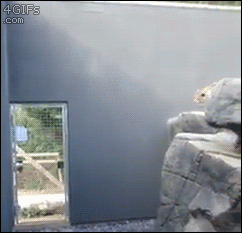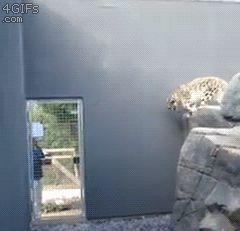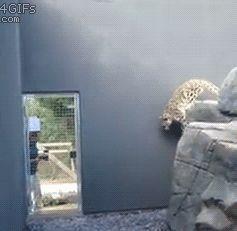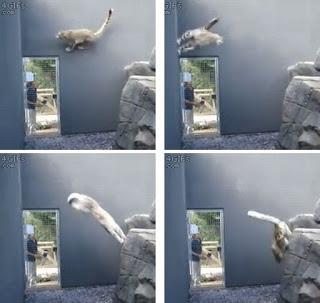Figure 1. I am pretty sure this move totally makes sense
I saw this on Twitter the other day and I couldn't stop watching it. What the ever-loving hell is that cat doing? Then I realised I had a hypothesis, and that it was a fun example of an ecological affordance analysis. So here we are, at last, with a cat-themed blog post. I'll review this manouver, claim that it's all about effecting affordances, and then chat a little about complex actions like this.Everyone who sees this tends to go "that cat is totally showing off" or "what a weird way to go". My first move was simply to assume that the leopard is not crazy or wasteful - quite the opposite. Behaviour emerges in real time as we work to move stably and interact functionally with the affordances of the environment. Animals aren't wasteful in their basic interactions with the world. So what is the relevant affordance, what is the relevant effectivity, and why was this three step jump a better way to effect the affordance than the 'simpler' one step straight down? In other words, from the first person perspective of the leopard, what is going on?
Here's my analysis.
Step 1. Look.
The first that happens is that the leopard approaches the edge, looks down, and starts preparing to jump.Step 2. Nope.
To begin, the leopard carefully places both front feet about 8in down the slope next to each other and begins to shift some weight onto them. It then changes it's mind and backs up - there's a problem.What's the problem? Why is this not going to work? The leopard wants to get lower, but can't. As soon as it places weight on it's front feet I think it perceives that it's slipping, so this won't work, even at the speed this cat is about to move. Why does it want to get lower? At this point, I have one hypothesis; it's initial height is too high and the lower height is low enough to afford an effective jump. There is an action boundary between the two heights. Having perceived that it cannot effect the initial jump, it immediately goes into the crazy 3 wall jump.
Step 3. Go nuts!
One thing to note is that none of the individual jumps take the leopard down far; vertical height certainly seems to be an issue. The final jump also begins about the height it would have happened from if the initial jump had worked out.It's at this point, though, I start to suspect height, while an order parameter, is not necessarily the thing being controlled (also, to be honest, it's just not that high for a leopard, I think). Look at the form of the four successful leaps. The push off the ground happens using all four feet bunched together and centred under the animal. This is the effectivity that I think the leopard wanted to use initially, and couldn't because it perceived it's front feet would slip before it's back feet got to the right place.There is another part to this. The final jump has the leopard jump at a very steep angle. This means it drops almost vertically, keeping away from the wall but without using up much of the small landing area. It's able to do this because at the launch point, it's finally able to point it's body down towards the ground.So my final hunch is this:The leopard wants to orient it's body so it's in a line pointing down at a steep angle with all four feet bunched and centred, and only then jump. This will let it land slightly away from the wall (no bumping into it) but not so far as to risk hitting the not-so-far far wall. It starts the move but immediately perceives that it won't be able to arrange it's feet into 'bunched and centred for jumping' before the front feet slip. It immediately stops this action and selects a new one. Another option was to jump from the flat surface it is standing on, but my guess is that the biomechanics of this jump will force a higher angle on the jump, which would carry the cat either farther or higher or both, and risk hitting the not-so-far far wall. Instead, it immediately makes three jumps that take it to a place where it can jump towards the ground from an initial posture of 'pointed down at a steep angle with all four feet bunched and centred'. All those jumps allow the bunched-feet launch (i.e. afford the leopard's preferred effectivity) and the result is the safe, effective landing.Some limitationsA couple of things of caveats here. First, the cat must have jumped off these walls before, and actually experienced the frictional forces generated between it's feet and the wall. Friction is a dynamical property that does not exist until two surfaces come into contact, and therefore there is no ahead-of-time (prospective) information about it. So learning is involved here.Second, the cat does not look ahead to the final launching spot. It goes immediately into this routine. This is the other thing that makes me think it's not the first time the cat has done this move. My prediction is that the first time, there will have been some slightly more prolonged visual exploration of the space, maybe starting at the final launch point and working backwards (on average; gaze flicks around a lot). But the fact it doesn't look on this one is a bit of a weakness of my analysis. Some thoughtsI don't think this cat is crazy. I think it was trying to effect the affordance of jumping down from that height using the dynamical form it takes when jumping (pointing down at a steep angle with all four feet bunched and centred). It could not do that from the initial point, so it simply moved itself to somewhere from which it could. Affordances are opportunities for action that help constrain the space of possible actions, but they do not constrain that space to just one option. As my recent targeted throwing work showed, an affordance can be effected in a bunch of ways that vary in effectiveness and stability in the face of noise. Skilled action is working to get to where the most stable option is an actual option, but we often have multiple options.The title of this post comes from a paper by Mark Latash, in which he reframes the classic degrees of freedom problem as 'the bliss of motor abundance'. The degrees of freedom problem is the fact that we can typically control more things than are required to solve a task; I have to reach to my coffee using an arm that has more joints and more possible postures than the one straight line transport of my hand, for example. Latash just notes that while this does pose a control problem, it is also critical flexibility; if that one, ideal solution is cut off (the cup is behind something, your arm is injured) and you cannot adapt, you are dead in the water. The constant job of the perception-action system is to perceive the affordance and implement the current best-fit action that makes that possibility for action a reality. And sometimes, that means you have to jump off three walls. David Rosenbaum has done a lot of work on the end-state comfort effect, in which people sacrifice initial ease for a comfortable final posture during a movement. The classic example is turning a wine glass up the right way; a typical adult will perform an initially slightly awkward twisted reach to grasp so that the turning action brings the hand back to a final, comfortable posture. The leopard is basically doing this, and I've always thought the end-state-comfort literature needed a good affordance analysis thrown at it. And of course, leopards aren't the only show-offs just responding to affordances :)





